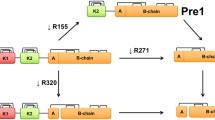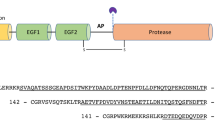Abstract
The interaction of the isolated human plasminogen kringle 4 with the four ω-amino acid ligands ε-aminocaproic acid (εACA), Nα-acetyl-l-lysine (AcLys), trans-aminomethyl(cyclohexane)carboxylic acid (AMCHA) and p-benzylaminesulfonic acid (BASA) has been further characterized by 1H-NMR spectroscopy at 300 and 600 MHz. Pronounced high-field shifts, reaching ∼ 3 ppm, are observed for AMCHA resonances upon binding to kringle 4, which underscores the relevance of ligand lipophilic interactions with aromatic side chains at the binding site. Ligand titration curves for the nine His and Trp singlets found in the kringle 4 aromatic spectrum reveal a striking uniformity in the kringle response to the various ligands. The average binding curves exhibit a clear Langmuir absorption isotherm saturation profile and the data were analyzed under the assumption of one (high affinity) binding site per kringle. Equilibrium association constants (K a ) and first order dissociation rate constants (k off) were derived from linearized expressions of the Langmuir isotherm and of the spectral line-shapes, respectively. The results for the four ligands, at ∼295 K, pH* 7.2, indicate that: (a) AMCHA exhibits the strongest binding (K a =159 mM -1) and εACA the weakest (K a =21 mM −1) with AcLys and BASA falling in between; (b) εACA dissociates readily (k off = 5.3 × 103 s−1) and AMCHA associates the fastest (k off = 2.0 × 108 M −1 s−1) while the kinetics for BASA exchange is relatively slow (k off = 0.8 × 103 s−1, k on = 0.6 × 108 M −1s−1); (c) the ligand-binding kinetics is close to diffussion-controlled.
Similar content being viewed by others
Abbreviations
- εACA:
-
ε-aminocaproic acid
- AcLys:
-
Nα-acetyl-l-lysine
- AMCHA:
-
t-aminomethyl(cyclohexane)carboxylic acid
- BASA:
-
p-benzylaminesulfonic acid
- K4:
-
kringle 4
- NOE:
-
nuclear Overhauser effect
- ppm:
-
parts-per-million
- pH* :
-
glass electrode pH reading uncorrected for deuterium isotope effects
- K a :
-
ligand-kringle 4 equilibrium association constant
- k off :
-
ligand-kringle 4 dissociation rate constant
- k on :
-
ligand-kringle 4 association rate constant
References
Bok RA, Mangel WF (1985) Quantitative characterization of the binding of plasminogen to intact fibrin clots. Biochemistry 24:3279–3286
Bundi A, Wüthrich K (1979) 1H-NMR parameters of the common amino acid residues measured in aquous solutions of the linear tetrapeptides H-Gly-Gly-X-L-Ala-OH. Biopolymers 18:285–297
Christensen U (1984) The AH-site of plasminogen and two C-terminal fragments. Biochem J 223:413–421
Cole KR, Castellino FJ (1984) The binding of antifibrinolytic amino acids to kringle 4-containing fragments of plasminogen. Arch Biochem Biophys 229:568–575
De Marco A (1977) pH dependence of internal references. J Magn Reson 26:527–528
De Marco A, Hochschwender SM, Laursen RA, Llinás M (1982) Human plasminogen: proton NMR studies on kringle 1. J Biol Chem 257:12716–12721
De Marco A, Laursen RA, Llinás M (1985a) Proton Overhauser experiments on kringle 4 from human plasminogen. Implications for the structure of the kringle's hydrophobic core. Biochim Biophys Acta 827:369–380
De Marco A, Pluck ND, Bányai L, Trexler M, Laursen RA, Patthy L, Llinás M, Williams RJP (1985b) Analysis and identification of aromatic signals in the proton magnetic resonance spectrum of the kringle 4 fragment from human plasminogen. Biochemistry 24:748–753
De Marco A, Laursen RA, Llinás M (1986) 1H-NMR spectroscopic manifestions of ligand-binding to the kringle 4 domain of human plasminogen. Arch Biochem Biophys 244:727–741
Deutsch DG, Mertz ET (1970) Plasminogen: purification from human plasma by affinity chromatography. Science 170: 1095–1096
Feeney J, Batchelor JG, Albrand JP, Roberts GCK (1979) The effects of intermediate exchange processes on the estimation of equilibrium constants by NMR. J Magn Reson 33: 519–529
Hochschwender SM, Laursen RA, De Marco A, Llinás M (1983) 600 MHz 1H-nuclear magnetic studies of the kringle 4 fragment of human plasminogen. Arch Biochem Biophys 223:58–67
Lerch PG, Rickli EE, Lergier W, Gillessen D (1980) Localization of individual lysine-binding regions in human plasminogen and investigations on their complex-forming properties. Eur J Biochem 107:7–13
Llinás M, De Marco A, Hochschwender SM, Laursen RA (1983) A 1H-NMR study of isolated domains from human plasminogen: structural homology between kringles 1 and 4. Eur J Biochem 135:379–391
Llinás M, Motta A, De Marco A, Laursen RA (1985) Kringle 4 from human plasminogen: 1H-NMR study of the interactions between α-amino acid ligands and aromatic residues at the lysine-binding site. Proc Int Symp Biomol Struct Interact (Suppl J Biosci) 8:121–139
Lucas MA, Fretto LJ, McKee PD (1983) The binding of human plasminogen to fibrin and fibrinogen. J Biol Chem 258:4249–4256
Markus G, Camiolo SM, Sottrup-Jensen L, Magnusson S (1981) Tranexamic acid binding to kringle-containing fragments of human plasminogen. Progr Fibrinolysis 5: 125–128
Markwardt F (1978) Synthetic inhibitors of fibrinolysis. In: Markwardt F (ed) Fibrinolytics and antifibrinolytics. Springer, Berlin Heidelberg New York, pp 511–577
Okamoto S, Oshiba S, Mihara H, Okamoto U (1968) Synthetic inhibitors of fibrinolysis: in vitro and in vivo mode of action. Ann NY Acad Sci 146:414–429
Ramesh V, Gyenes M, Patthy L, Llinás M (1986) The aromatic 1H-NMR spectrum of plasminogen kringle 4: a comparative study of human, porcine and bovine homologs. Eur J Biochem 159:581–595
Sottrup-Jensen L, Claeys H, Zajdel M, Petersen TE, Magnusson S (1978) The primary structure of human plasminogen: isolation of two lysine-binding fragments and one “mini”-plasminogen (MW, 38,000) by elastase-catalyzed-specific limited proteolysis. Progr Chem Fibrinolysis Thrombolysis 3:191–209
Sudmeier JL, Evelhoch JL, Jonsson NBH (1980) Dependence of NMR lineshape analysis upon chemical rates and mechanisms: implications for enzyme histidine titrations. J Magn Reson 40:377–390
Thorsen S, Clemmensen I, Sottrup-Jensen L, Magnusson S (1981) Adsorption to fibrin of native fragments of known primary structure from human plasminogen. Biochim Biophys Acta 668:377–387
Trexler M, Bányai L, Patthy L, Pluck ND, Williams RJP (1983) NMR studies on native and several chemically modified kringle 4 species of human plasminogen. FEBS Lett 154:311–318
Váli Z, Patthy L (1982) Location of the intermediate and high-affinity ω-aminocarboxylic acid-binding sites in human plasminogen. J Biol Chem 257:2104–2110
Váli Z, Patthy L (1984) The fibrin-binding site of human plasminogen: arginines 32 and 34 are essential for fibrin affinity of the kringle 1 domain. J Biol Chem 259:13690–13694
Wiman B, Collen D (1978) Molecular mechanism of physiological fibrinolysis. Nature 272:549–550
Winn ES, Hu SP, Hochschwender SM, Laursen RA (1980) Studies on the lysine-binding sites of human plasminogen: the effect of ligand structure on the binding of lysine analogs to plasminogen. Eur J Biochem 104:579–586
Author information
Authors and Affiliations
Rights and permissions
About this article
Cite this article
De Marco, A., Petros, A.M., Laursen, R.A. et al. Analysis of ligand-binding to the kringle 4 fragment from human plasminogen. Eur Biophys J 14, 359–368 (1987). https://doi.org/10.1007/BF00262321
Received:
Accepted:
Issue Date:
DOI: https://doi.org/10.1007/BF00262321




